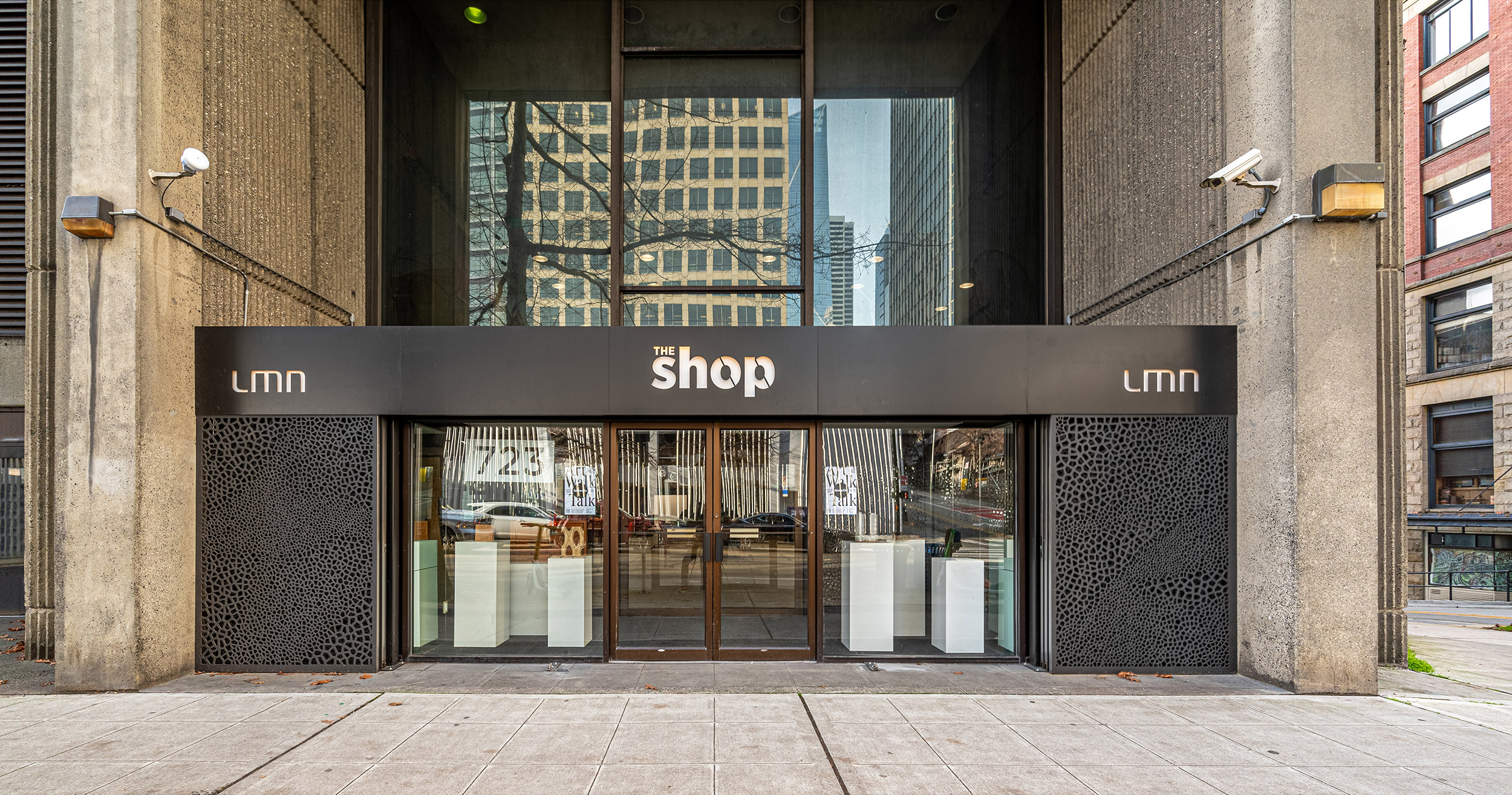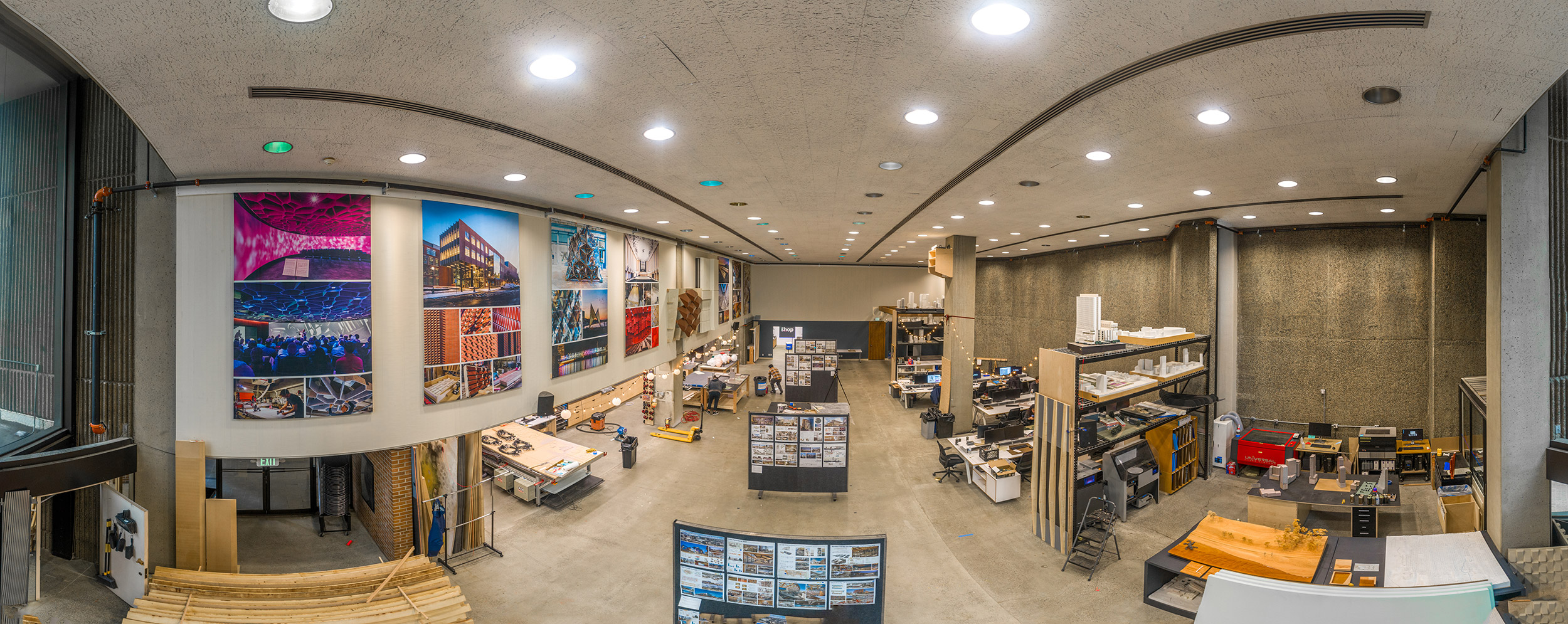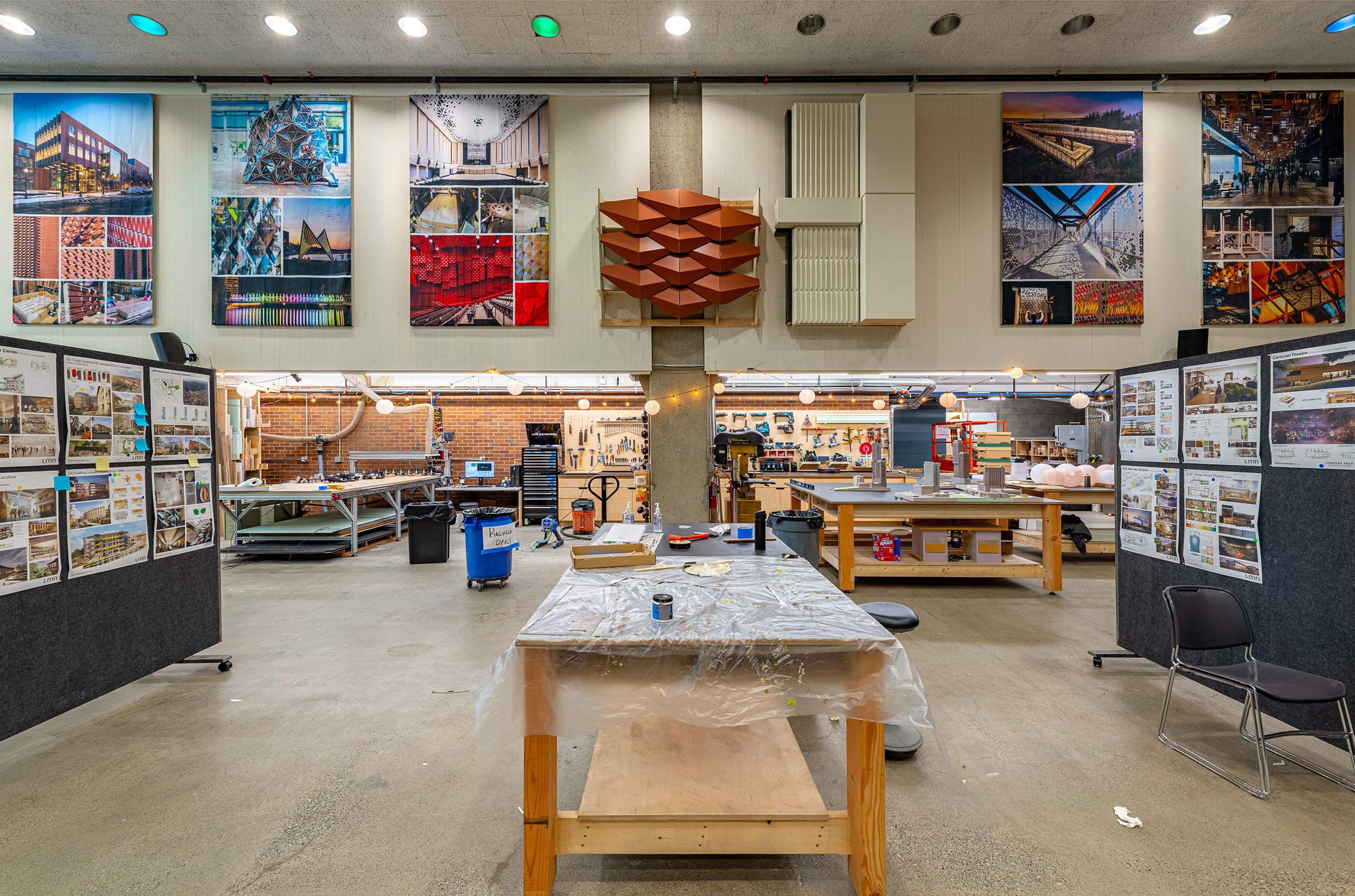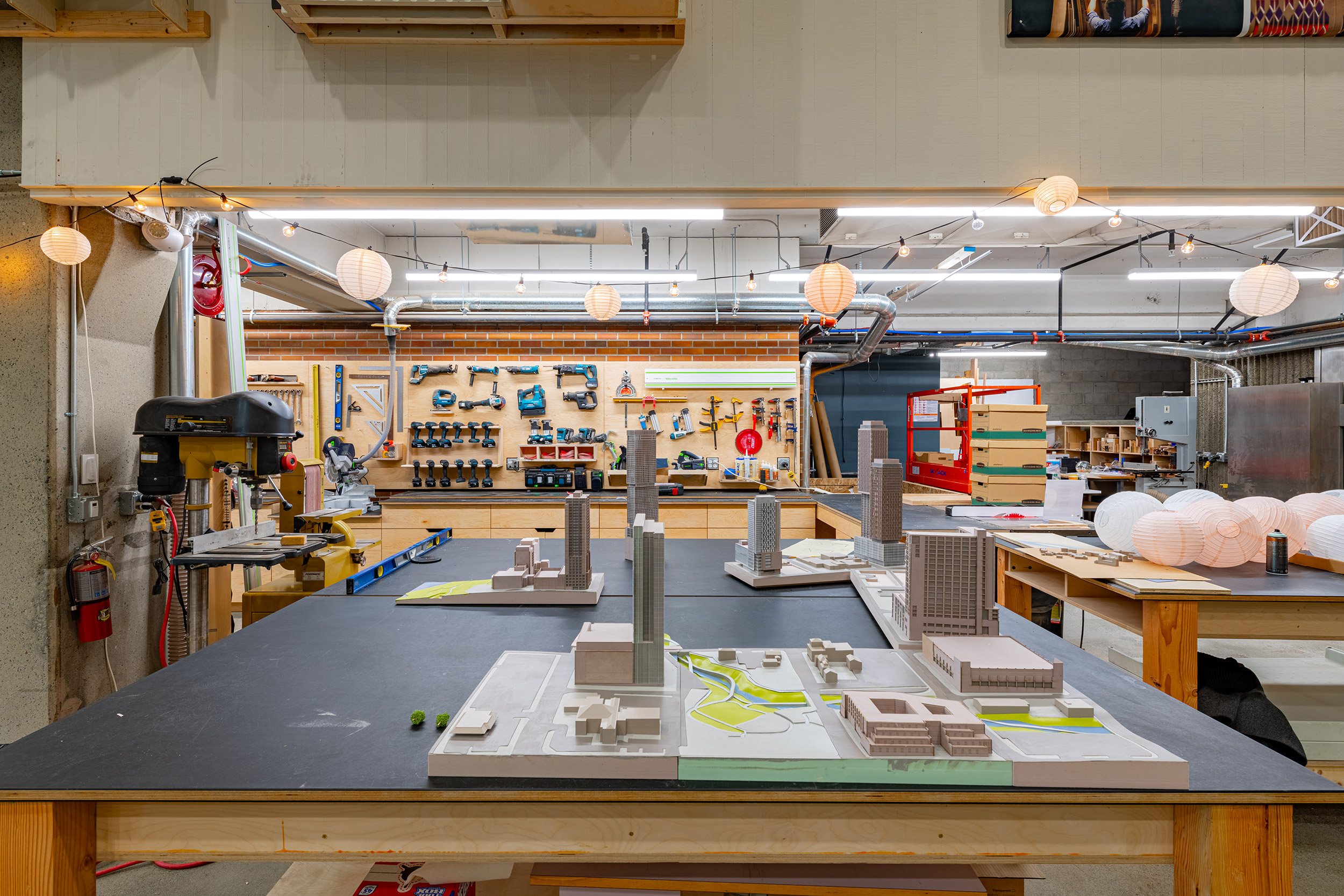
[All images by BUILD LLC]
Earlier this winter, BUILD visited the LMN Shop in Seattle’s Pioneer Square and sat down with Scott Crawford and Hank Butitta. We discussed the advantages and challenges of architects moving between design and in-house fabrication.
Tell us how The Shop began.
Scott Crawford: Around 2009, we began having broad conversations, as a firm, about what it means to adopt new tools and technologies. Because LMN fosters a culture that’s constantly seeking to innovate in everything we do, there was real receptiveness to the idea of a shop, but there was also concern about noise, safety, mess, and room in the office. At the time we weren’t able to find another space in the building, so we started in my garage, and a few of us advocated for a CNC (computer numerical control) machine to flesh out our laser and hot wire foam cutters.
Hank Butitta: The timing was good, as the maker of CNC router parts developed a kind of kit of parts that made the technology easier to understand and use. This was the first time CNC machines were accessible to the hobbyist. This particular machine cost about $10k to setup, whereas industrial machines are $50-$100k.
Did you have to enroll the company in financing The Shop? If so, what were the convincing arguments?
SC: In 2009 we started an internal R&D group called Tech Studio—we weren’t sure what the studio would do, but we wanted to explore how we could leverage a variety of new tools in professional practice. Because it was an experiment, there was never a discussion about return on investment. It was purely speculative. The Shop is an outgrowth of this studio, though the tech group still exists in the office. Today, it is a central belief of the firm’s that The Shop is essential to how we should design. It’s not an add service. The great part of having this much space is that we can welcome and share the experience and possibility with everyone.
HB: Previously, we were always pushing the boundaries of what we were capable of doing in the space we had, and we simply outgrew it. Unless we were able to expand, our capacity to evolve would have been capped—we were also limited in how many folks we could share the tools with at a given time because the former space was so small. The Shop has allowed us to experiment and interact at a much more generous level.
As an aside, there are a couple of reasons why this happened at LMN. First, we’re a single office, albeit a large one, and everyone who needs to weigh in on decisions sits at the same table every week. So, it’s easier to gain consensus. LMN isn’t a firm that tells its employees how to work; they give you the tools to work the way you want to work. This creates comfortable pathways for people to explore.
SC: The Shop is real evidence of that. The initial group of us who started it told the firm that we were going to begin in my garage, AND we will bill you for every hour of our time experimenting—oh, and we need to buy a machine. We were able to demonstrate that we hatched a plan, acted on it, and were subsequently successful. Then, when we started to imagine what a larger dedicated space could be, eight to ten of us developed a proposal and went to leadership and asked for a project billing number, and told them that over the next two to three months, we were going to put together a case for why we need to increase the capacity of The Shop. They agreed, without caveats, that we should take this on. We still had to find a space and figure it out, but because those of us who were leading the charge wanted to see it succeed, we were motivated.

What advantage does your work at The Shop give you with the design process?
HB: So many. Architecture has a reputation for wishful thinking, but the advances in parametric design are making more things possible—buildable. We understand clients and builders reluctance to accept a design where every single element is a custom shape; that’s where we come in. We demonstrate how the elements of a design can be machined and built. We can do it ourselves, and our ideas are plausible and feasible.
SC: It also allows us to stay closer to our design intent. When we show up at a meeting with smart artifacts that demonstrate what’s possible, and on budget, it’s pretty powerful. It gives us more credibility. Also, there’s a fundamental need for us to take the design out of the computer and fabricate it, so we know what’s possible. Then we can meet with a GC and say: “We think we found a way to build this,” while being respectful of their challenges.
HB: Moving forward, once a contractor buys into the idea, we’re going to fill in the missing links between the final drawing set and the contractor mockup by creating more mockups that study specific details and test our understanding of a given assembly. For example, for a façade that has a parametric skin, we want to fully understand how the panels meet and overlap before we send it out in the final documents. This will save resources later.
Do you ever find that GCs are threatened or intimidated by this?
SC: In many cases we’re able to gain traction when they already understand the potential. In other situations, we have to work really hard to communicate the value. There’s an ongoing conversation in our office about what a 3D model means as a deliverable. There’s concern that it’s not a perfect model, which it may not be, but it does contain necessary and useful information; it’s not a lump of dumb geometry. There’s more work to do in the industry and in our own office to better convey the value of this technology as part of the process. A lot of people don’t know how to interact with it, so our intentions are not always understood.
HB: On a related note, The Shop’s adjacency to our home office affords seamless access for the entire staff; and being at street level in a historic and storied neighborhood makes it easy to invite people in to learn about what we’re doing. We’re modeled after educational shops—we want to teach new concepts. We want people to be comfortable with the tools and resources so they can use them to their and their team’s advantage.

As architects, rather than the contractor, how do you decide how much responsibility and risk you’re willing to assume?
SC: It’s becoming clearer with time. Early on, we would only look to the construction documents for guidance. But when we started doing this work, we ended up with a lot of fabricated studies that would ultimately prove useful to the contractor. We don’t present them as necessarily definitive, and we’re essentially giving these examples to them for free. Doing the work allows us to remain closer to our design intentions. Now we’re in the position of providing 3D models, but there is no documentation in the 2D set that shows how to build them. We need the models to be the deliverable, but with caveats. We’re talking with our lawyers about how to convey that the model represents a set number of things, but not all. We’re also fabricating elements to be installed on projects because no one else was stepping up to do so. Our general liability insurance covers us to make these things, but we’re signing contracts now with clients, as a sub to the contractor, to provide a set of goods, but we need to consider our product warranties. We’re still experimenting with this to find how best to engage—we’re looking for opportunities. We don’t want to be fabricators for all of our projects, but we do want to learn and grow.
I’m sure there are a lot of contractors who would appreciate it if you would fabricate whatever is needed. How do you stick to your guns with that?
SC: In some instances we will explore what it would take to fabricate something ourselves, and we may do it, but more typically the contractors don’t ask because they don’t understand our savvy in this arena.
HB: The Shop and its staff are somewhat finite, so we have to be strategic in what we take on. And it has to make sense for us to do it rather than a specialty fabricator. For me, it’s about giving the client the best possible solution, and if that means we fabricate it, then we’re going to be open to that. We want to build better relationships, and this is one of the ways we can achieve that.
SC: We have a project coming up that’s using mass plywood from a lumber supplier in Oregon; we learned that the way they work is to gather all drawings from the designers, then ship them off to a third party that prepares shop drawings, and then it goes back to the lumber supplier who cuts the wood. This opens the door for error and misunderstanding. So we’re considering how we can eliminate the third party and do the shop documents ourselves.

What has been the greatest unforeseen benefits or surprises of having The Shop?
SC: In addition to amassing the resources that comprise The Shop, we knew we wanted to invite others in, and in the last year we’ve done just that. We’ve hosted a diversity of events, including house parties and hosting non-profits; these gatherings are intriguing, and we really enjoy interacting with the community by sharing what we’re doing and learning. We couldn’t do this from our offices in the Norton Building. While we were initially motivated by wanting access to tools, the impression that this space has on people is powerful, particularly students who are thinking about what a career in architecture might look like. They come in here and want this. It’s eye-opening. There’s a fundamental desire to make things and break things. We’ll also be participating in the monthly Pioneer Square First Thursday Art Walk.
HB: To echo that, I knew The Shop would deepen our skills as an office, but I was caught off guard by the relationship with the neighborhood that blossomed. We’re now part of Pioneer Square in a way that we couldn’t have imagined. It’s a community space.
What are the lessons you’ve learned so far?
SC: Understanding that like anything new, this is an experiment and the end goal isn’t clear. You have to learn a lot of new things, there will be failures, and there will be successes. In order to find the benefits, a loose approach is necessary. Looking back, when we first started to think about this over ten years ago, we didn’t imagine it at this scale, but it felt natural. Our openness to the possibility really benefitted us along the way.
How are you documenting this experiment? Will there be a book?
SC: We’ve been here for less than a year, so we’re still figuring it out. We’re looking forward to watching it unfold. Who knows what it will look like in the future.
 Scott Crawford joined LMN in 2009, was a Founding member of LMN’s Tech Studio, and was made partner in 2023. His experience ranges from higher education, performing arts, and civic projects.
Scott Crawford joined LMN in 2009, was a Founding member of LMN’s Tech Studio, and was made partner in 2023. His experience ranges from higher education, performing arts, and civic projects.
He received a Bachelor of Arts in Psychology from the University of Maryland, and a Master of Architecture and a Master of Science in Design Computing from the University of Washington.
 Hank Butitta joined LMN in 2016 and is the Shop Fabrication Manager where he oversees all fabrication facilities and consults with LMN project teams. He earned a Bachelor of Science in Architecture and a Master of Architecture from the University of Minnesota. Prior to LMN he operated a small design/fabrication practice that specialized in custom furniture, and he taught materials-focused courses to undergraduate architecture students at UMN.
Hank Butitta joined LMN in 2016 and is the Shop Fabrication Manager where he oversees all fabrication facilities and consults with LMN project teams. He earned a Bachelor of Science in Architecture and a Master of Architecture from the University of Minnesota. Prior to LMN he operated a small design/fabrication practice that specialized in custom furniture, and he taught materials-focused courses to undergraduate architecture students at UMN.





